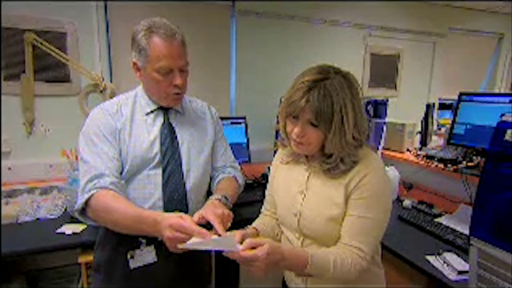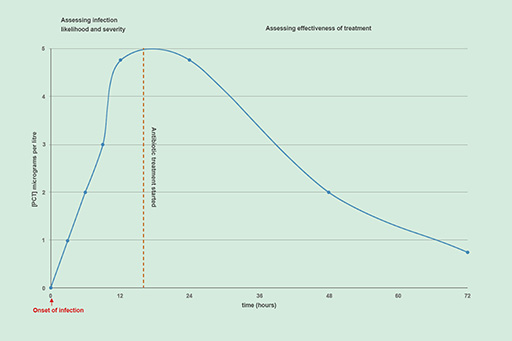4.3.1 Detecting the patient infection response
Some tests detect chemicals produced by the patient in response to infection – these are known as
In the following video you will see how PCT tests can be used in clinical practice to reduce the unnecessary use of antibiotics. You can then practise interpreting PCT levels in Activity 6.

Transcript: Video 5 How rapid diagnostic testing for PCT reduces unnecessary antibiotic prescribing.
Activity 6 Interpreting PCT levels
Figure 11 shows the levels of PCT – in micrograms (μg) of PCT per litre of serum – in a patient with an infection and receiving treatment over 3 days (72 hours).
Study Figure 11 carefully and then answer the questions below.
- How do the patient’s PCT levels change over the 72-hour period?
Answer
The patient’s PCT levels rise from 0 at infection onset to 5 micrograms per litre after approximately 16 hours. When antibiotic treatment starts, PCT levels decline from 5 micrograms per litre to less than 1 microgram per litre after 72 hours.
- Does the patient have a bacterial infection? How can you tell?
Answer
Yes, the patient’s PCT levels rise from 0 at infection onset to 5 micrograms per litre after approximately 16 hours. Elevated PCT levels indicate that the patient has a bacterial, rather than a viral, infection.
- Is the antibiotic treatment effective? How can you tell?
Answer
Yes. Once, antibiotic treatment has started, the patient’s PCT levels decrease from 5 micrograms per litre to less than 1 microgram per litre, indicating that the patient’s infection has cleared and the antibiotic treatment is effective.
- How could measuring the PCT levels in a patient be used to reduce unnecessary antibiotic use?
Answer
Decreasing PCT levels show that the infection is being effectively treated by the prescribed antibiotics. If PCT levels remain high after treatment, doctors could quickly prescribe an alternative treatment, reducing the need to take ineffective antibiotics for an extended period.

